
Back in September 2021, email senders were coming to terms with the news that the open rate metric—a staple of email marketing reporting—was about to change forever.
This was when Apple introduced Mail Privacy Protection (MPP), a suite of privacy measures that would automatically download email images (including tracking pixels) regardless of whether the recipient actually opened the email. This caused open rates to skyrocket—but not because more people were truly engaged. MPP also restricted the identification of the devices subscribers were using and obscured their IP addresses, making it harder to determine their location.
One year later, we’re revisiting Apple’s MPP and exploring how it’s impacted senders and the email landscape as a whole. Let’s dive in.
How has MPP impacted senders?
In a survey published by Marketing Charts earlier this year, 39 percent of respondents said MPP is already having a significant impact on their company. Another 50 percent said they believe it will begin having an impact over the next year, and two-thirds believe it will change email marketing permanently.
Their top concerns were that MPP makes open times unknown, reduces the effectiveness of interactive emails, and creates inaccurate email segmentation through factors like loss of geolocation. Thirty percent also listed open rate inflation as a major concern.
During the latest edition of our State of Email (SoE) webinar series, we took the opportunity to ask the audience how they’re feeling about MPP 12 months down the line… and there wasn’t much positivity (see below).
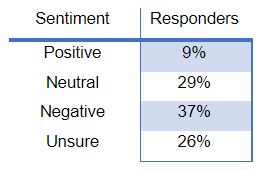
The concerns about open rate inflation were particularly well-founded. In the October 2021 edition of SoE, we reported that after just one week of MPP, Apple Proxy opens already formed 20 percent of all opens and were literally increasing on a minute-by-minute basis! Apple-generated pixel fires have now settled at ~70 percent of all opens.
Chad White, Head of Strategic Research at Oracle, has published research showing that if a sender’s pre-MPP Apple Mail open rates were 20 percent, they’ll now have an approximate 4-to-1 ratio of fake to real opens—meaning 80 percent of their reported opens are garbage data.
This has led to mailbox providers (MBPs) updating their reporting to provide users with a better view of their “true” opens. Oracle now removes auto opens from its reported open rates to provide a cleaner engagement signal. Klaviyo exposes the Apple Open indicator for segmentation purposes, while MailUp shows the ratio of MPP opens to total opens. At Validity, Everest’s engagement analytics split out the proxies from the platforms to help senders identify granular use cases that include valid recipients, unique opens, geolocation, client/device, and potential false positives.
The Marketing Charts survey also highlighted “Decreased email deliverability” and “Decreased email engagement” as major concerns. These topics are very close to our hearts at Validity, and senders are right to be concerned!
Email Deliverability
Our SoE Email Analytics data shows global email volumes have sharply increased over the past two months, with a big rise in online shopping during the summer (see below).
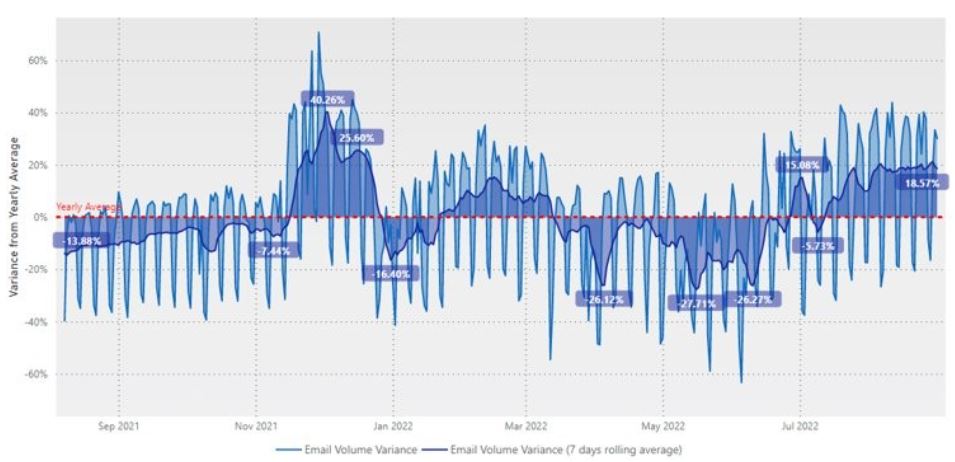
However, global deliverability has gone down by two percentage points (open and click rates have also decreased), under pressure from factors like increased trap hits and spam complaints. Deliverability will be a bigger challenge than ever during the upcoming holiday season, with MPP meaning many senders may have overly optimistic expectations for their subscriber engagement levels.
Deliverability is clearly a core issue at Apple. Validity’s global network of MBPs currently shows the following inbox placement rate (IPR) benchmarks:
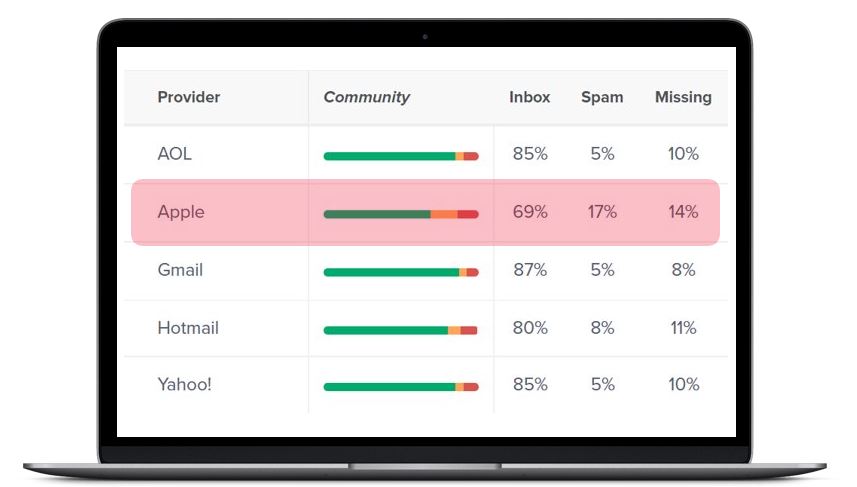
While Gmail, Microsoft (Hotmail), and Yahoo/AOL are all running at or above 80 percent, Apple is substantially worse at only 69 percent, and spam placement rates are between two and three times higher at 17 percent.
Sender guidance from Apple’s postmaster is very similar to the other MBPs, focusing on the following:
- Consent
- Infrastructure
- Authentication
- Engagement
The first three should be consistent—if they hold true for one MBP, they will hold true for all—which suggests subscriber engagement is worse at Apple, because it’s harder to measure subscriber engagement at this MBP.
Email Engagement
Many senders have now abandoned open rates as their preferred measure of engagement, with many shifting to click rates instead. This is a good thing because clicks provide a more accurate measurement of engagement. However, the downside is there are fewer of them, and they are generated more frequently.
This has driven email marketers to adopt a broad range of click optimization tactics. For example, Morning Brew has taken an innovative approach by simply asking subscribers to generate more clicks for them!
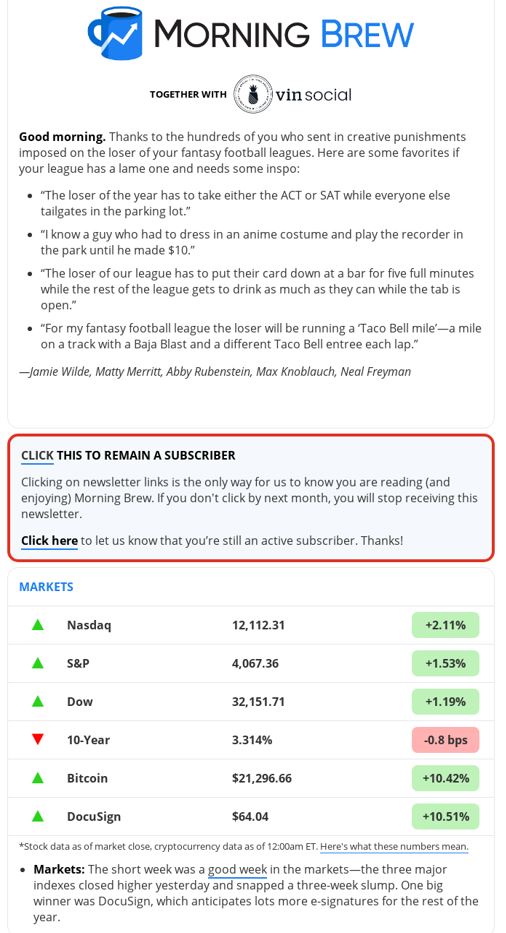
There has also been a big shift towards the use of zero-party data that is explicitly provided by email subscribers, rather than inferred from their behaviors. For marketers, this has made preference centers front-of-mind. While preference centers are often an email program’s best-kept secret, senders are now more proactive in promoting them and encouraging subscribers to use them.
For example, in the following email campaign, Harrods highlights their preference center and encourages subscribers to update their preferences so they can receive content that is most relevant to their interests.
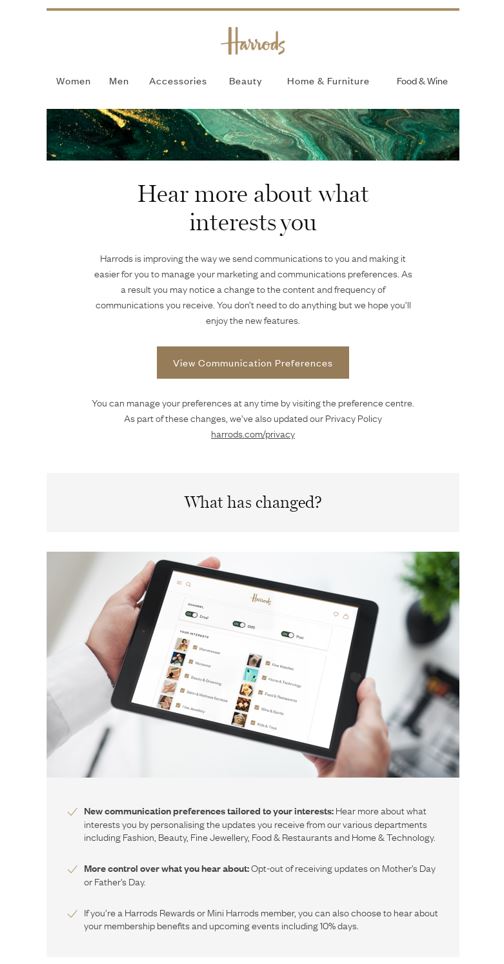
Senders are also learning that relying on subscribers to provide indicators of engagement means providing the tools for them to do so, in ways that are more visible and easier to use. For example, including an unsubscribe link as part of the email pre-header is a great tactic. While opt-out rates may increase, spam complaints will reduce—often by a lot more!
What’s next for email marketers?
Sometimes it’s necessary to view difficult situations in a slightly different way to find the silver lining. Proactive marketers have embraced MPP as an opportunity to innovate, and they are benefitting from increased levels of subscriber engagement.
Want to learn more about the tactics and best practices that are being used to achieve increased levels of subscriber engagement? Check out our most recent episode of State of Email Live for a deeper dive into the topic.